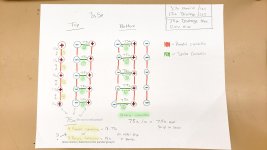NinjaKitten
100 µW
Saw this video on YouTube - www.youtube.com/watch?v=tKg-jIrr_JE&t=12m25s
(Only this 20 second part matters in this question)
Was still a bit confused in my quest to figure out more about building an 18650 battery. I had a question about series and parallel connections. More specifically, how do I choose the correct nickel strip thickness to handle the current, and how much current is passing through it.
Say I had a 3s5P battery.
Each cell is rated for 15A Discharge, 5A Charge, and 2500mah Capacity.
With those specs, the battery should be able to provide a maximum of 75A Discharge, and support a maximum of 25A Charging. While being 12.6v @ 12.5Ah for Volt and Capacity.
So if for example, the battery was delivering the full 75a load to a motor:
Obviously I would make a battery with about 20% more headroom all around if I were trying pull close to its max. And anything high current, Id use the correct gauge wire going all the way down the parallel groups for the main positive and negative leads, but I digress.
Just trying to make sure I’m doing this right!
Here’s a diagram I drew so you can visualize what I’m thinking and trying to figure out….

(Only this 20 second part matters in this question)
Was still a bit confused in my quest to figure out more about building an 18650 battery. I had a question about series and parallel connections. More specifically, how do I choose the correct nickel strip thickness to handle the current, and how much current is passing through it.
Say I had a 3s5P battery.
Each cell is rated for 15A Discharge, 5A Charge, and 2500mah Capacity.
With those specs, the battery should be able to provide a maximum of 75A Discharge, and support a maximum of 25A Charging. While being 12.6v @ 12.5Ah for Volt and Capacity.
So if for example, the battery was delivering the full 75a load to a motor:
- Would the 3 parallel groups be hit with 75a EACH? So 75a/5 = 15A going to each cell in each parallel group…. Or would that 75a be distributed between the 3 groups, effectively meaning they each would be hit with 25a? So 25a/5 = 5A going to each cell in each parallel group.
- Whichever load the group is hit with, would be distributed by the 5 Cells in the parallel group either way. So if for example, 75a / 5 = 15A, that means I would need either two 0.15mm nickel strips (rated for ~ 7a each), or one 0.3mm nickel strip along those cells to handle the 15A going to each one, correct?
- For the series connections – I would have 10 connections all together between the 3 parallel groups. I know series connections need to handle the full load, so would each of those 10 series connection need to handle 75a (aka 10!! Nickel strips for each series connection)?
Or would it be the same math basically; 75a / 10 connections = 7.5a needed to be handled for each series connection (so one or preferably two 0.15mm nickel strips used on each one).
Obviously I would make a battery with about 20% more headroom all around if I were trying pull close to its max. And anything high current, Id use the correct gauge wire going all the way down the parallel groups for the main positive and negative leads, but I digress.
Just trying to make sure I’m doing this right!
Here’s a diagram I drew so you can visualize what I’m thinking and trying to figure out….


